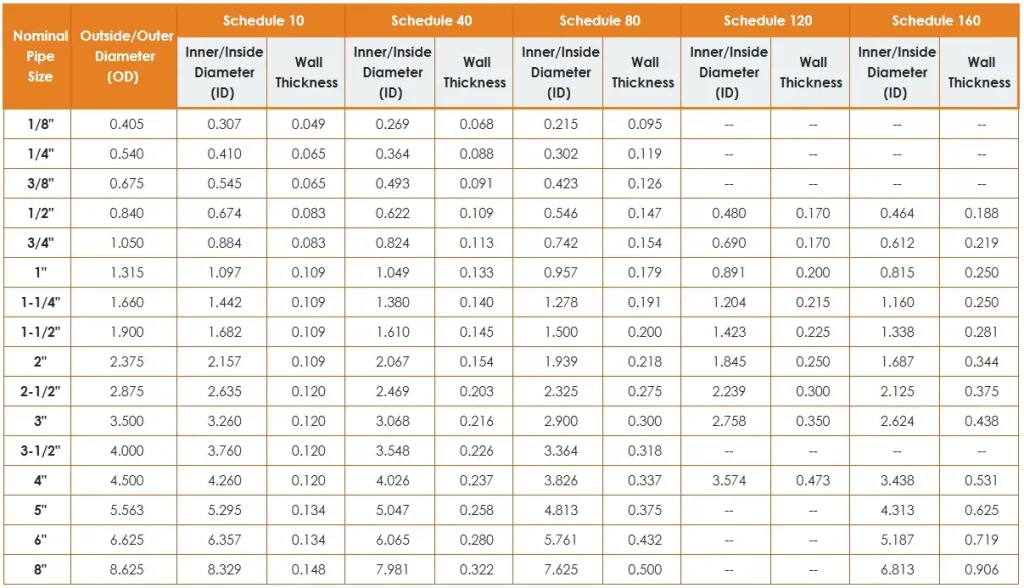When designing, purchasing, or installing piping systems, understanding the distinction between nominal and actual pipe diameters is crucial. Although these terms are often used interchangeably in casual conversation, they have distinct technical meanings that impact engineering calculations, product compatibility, and system performance.
1. Definitions and Key Concepts
Nominal Pipe Diameter
-
Definition:
The nominal pipe diameter (NPD) is a standardized, or “nominal,” measurement used to designate a pipe’s size in industry catalogs and specifications. It is essentially a nameplate size that simplifies ordering and designing piping systems. -
Usage:
Nominal diameters are used across various piping materials—such as ductile iron, PVC, and steel—to provide a consistent reference. For example, a “4-inch” pipe does not exactly measure 4 inches in any physical dimension; rather, it is a conventional label that may correspond to the pipe’s internal diameter or an approximate average.
Actual Pipe Diameter
-
Definition:
The actual pipe diameter is the true, measured size of a pipe’s dimension. This measurement is obtained through physical measurement and can refer to the external diameter, the internal diameter, or both, depending on the context. -
Usage:
The actual diameter is crucial for calculations involving flow capacity, material use, and connections. It ensures that engineers and installers understand the exact dimensions needed for precise fitting and mechanical integrity.
2. Why the Difference Matters
Engineering and Design
-
Flow Calculations:
The actual internal diameter of a pipe directly affects the fluid dynamics inside the conduit—determining flow rate, friction losses, and overall efficiency. -
Structural Integrity:
Knowing the actual external diameter helps in designing supporting structures and ensuring that installations meet regulatory clearances and mechanical loading requirements.
Procurement and Compatibility
-
Standardization Versus Reality:
Using nominal diameters simplifies ordering and categorization, but engineers must verify actual dimensions to ensure compatibility with flanges, valves, and fittings. -
Installation Accuracy:
Mismatches between nominal and actual dimensions can lead to installation errors, wasted materials, or even system failure if not properly accounted for during design.
3. Data Table: Nominal vs. Actual Dimensions
Below is a representative example showing how nominal sizes relate to actual pipe dimensions. Keep in mind that dimensions can vary based on pipe material, wall thickness, and manufacturing standards.
| Nominal Pipe Size | Actual Internal Diameter (approx.) | Actual External Diameter (approx.) | Note |
|---|---|---|---|
| 2 inches | 2.067 inches | 2.375 inches | Common in PVC and cast iron pipes |
| 4 inches | 4.026 inches | 4.500 inches | Standard for many water distribution systems |
| 6 inches | 6.065 inches | 6.625 inches | Typically measured in ductile iron pipes |
| 8 inches | 8.013 inches | 8.625 inches | Example for both metric and imperial standards |
Table Note: These values are for illustration purposes and actual dimensions will depend on the specific industry standard (e.g., ASTM, ISO, EN) and the type of pipe being used.

4. Case Studies: Real-World Impact
Case Study 1: Municipal Water Distribution
In a recent municipal upgrade project, a city switched to ductile iron pipes labeled with nominal sizes for ease of ordering. However, the engineering team closely reviewed the actual internal diameters to recalibrate pump capacities and flow rates accurately.
Outcome:
-
Optimized Flow: Adjustments based on the actual flow area resulted in a 15% improvement in water distribution efficiency.
-
Accurate Fittings: Ensuring that the actual external diameters matched with flanges minimized leak risks and installation setbacks.
Case Study 2: Industrial Piping System Design
An industrial facility required precise connections in a high-pressure steam system. Although the pipe supplier referenced nominal sizes for cataloging, the design team measured the actual dimensions to ensure that the fabricated joints and seals met the rigorous tolerances necessary for high-pressure operation.
Outcome:
-
Enhanced Safety: Verification of actual dimensions contributed to the system’s reliability and safety under extreme operating conditions.
-
Cost Savings: Early identification of discrepancies prevented costly modifications during the installation phase.
Nominal and actual pipe diameters serve different yet complementary roles in piping system design. While nominal sizes offer a standardized way of classifying and ordering pipes, the actual dimensions are vital for accurate flow calculations, structural design, and ensuring product compatibility.
References:
- Nominal Pipe Size – Wikipedia
- ASTM A53 – Standard Specification for Pipe, Steel, Black and Hot-Dipped, Zinc-Coated, Welded and Seamless – ASTM International
- ISO 6708:1995 – Pipes and Fittings — Dimensions of Pipes — Designation of Dimensions – International Organization for Standardization (ISO)
- Pipe Dimensions and Nominal Sizes – Engineering Toolbox
- Water System Design Manual – Pipe Sizing and Dimensioning – National Academies Press (NAP)

